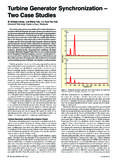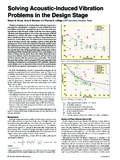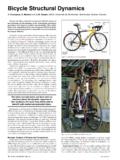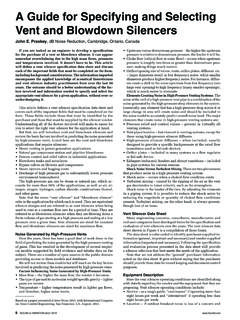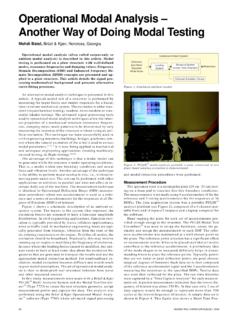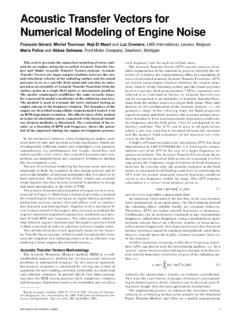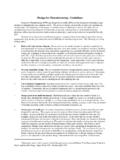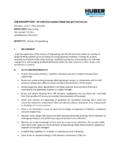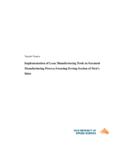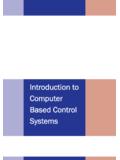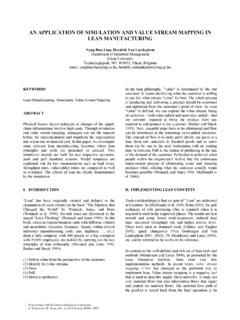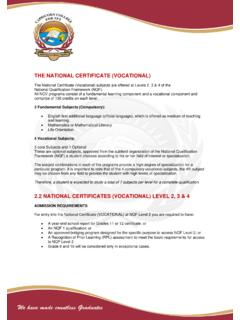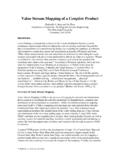Transcription of Manufacturing Tolerances and Axle System NVH …
1 12 SOUND AND VIBRATION/APRIL 2006 Manufacturing Tolerances andAxle System NVH PerformanceZhaohui Sun, Mark Ranek, Michael Voight and Glen SteyerAmerican axle & Manufacturing , Inc., Detroit, MichiganA study of axle System noise, vibration, and harshness(NVH) performance using design for six sigma (DFSS) meth-ods is presented with a focus on System robustness to typicalproduct variations ( Manufacturing -based Tolerances ). Insteadof using finite-element analysis (FEA) as the simulation tool,a lumped-parameter System dynamics model developed inMATLAB/Simulink is used in the study. This provides an effi-cient way to conduct large analytical design of experiment(DOE) and stochastic studies. The model s capability to pre-dict both nominal and variance performance is validated withvehicle test data using statistical hypothesis test driveline System variables that contribute to axle gearnoise are identified and their variation distributions in pro-duction are obtained through sampling techniques.
2 Throughanalytical DOE and analysis of variance (ANOVA) analyses,the critical design parameters that control System NVH varia-tions with respect to product variations and variations due tooperating conditions are covered. Design criteria of axle sys-tems with respect to robust NVH performance are also gear whine is a major NVH concern in vehicle drivelinesystems. The noise source is typically the hypoid-gear-mesh,first-harmonic transmission error, which further transformsinto dynamic gear mesh force under operation. The dynamiccharacteristics of the mesh force are controlled by the gear traintorsional dynamics. The driveline System translational dynam-ics and the impedance characteristics at the axle interface withthe vehicle are also important in defining the final vehicle in-terior gear-mesh noise progress has been achieved in recent years inunderstanding the physics of axle System gear noise.
3 Usingcomputer-aided engineering (CAE) tools such as FEA to ana-lyze System dynamics in regard to gear noise have been foundto be extremely In most applications, linear sys-tem assumption is satisfied, and a modeling approach calledthe building-block method has proven to be efficient and ac-curate. In dealing with gear mesh geometry, a simplified lin-ear gear-mesh model developed by Steyer et ,5 is widelyused. Figure 1 shows a typical rear-beam axle driveline FEAmodel and Figure 2 gives its accuracy with respect to vehicletest the success of applying simulation tools in design/tuning of System dynamics to achieve a quiet System for a par-ticular vehicle platform, it is even more important that theproduct has robustness in NVH performance in the followingaspects: The System meets the NVH requirements in the presence of variability due to both Manufacturing process capabilityand environmental/operating conditions.
4 The axle subsystem exhibits minimized System sensitivityto different vehicle general, the robustness of a System can be establishedthrough two aspects of the design: parametric design and tol-erance The parametric design deals with nominal sys-tem design through design parameter settings to achieve re-duced System sensitivity to variations. Current CAE tools canbe effectively used to achieve a viable nominal design. A goodexample of parametric design are the results presented by Sunet al.,1 where systems are desensitized to variations throughenforcing NVH design specifications that are rolled down fromanalytical studies. Monte Carlo-type optimization methods forparametric design are being tolerance design, on the other hand, deals with manu-facturing process capability. This is to identify critical toler-ances that contribute to System NVH performance variabilityand tighten specifications in an effective and economic fash-ion to minimize System variation.
5 A tolerance optimization ismost effectively done after a parameter 3 illustrates the concept of both parametric and tol-erance designs. Literature on parametric design studies andsuccessful implementation can be found in recent years. How-ever, there are few studies on tolerance designs regarding axlesystem NVH. There are several reasons behind this: It requires an integrated analytical approach that combinesstatistical and analytical DOE (design of experiment) tech-niques with simulation tools. However, traditional simula-tion tools such as FEA are still time consuming for this kindof task. For instance, if one would conduct a three-level fullfactorial DOE with six parameters, 729 runs are on Paper #2005-01-2309, Variation Reduction of axle Sys-tem NVH, 2005 SAE International, presented at the Noise & Vibra-tion Conference, May 16-19, Traverse City, MI 1. FEA model of rear-beam axle PredictionVehicle test, 1st gear meshVehicle test, 2nd gear mesh01000dB re 1 m/s2 Frequency (Hz)1st mesh harmonics 2nd mesh harmonics20 dBFigure 2.
6 Example of FEA model correlation to test AND VIBRATION/APRIL 2006 It requires a tremendous effort to obtain the statistical datafor the component-level parameters as inputs to the analyti-cal models. In many cases, special tests have to be designedand conducted on large sample sizes to obtain work here focuses on the tolerance design. To facilitatethe analytical study, a stand-alone, lumped-parameter axlesystem dynamic model built in MATLAB/Simulink is developedand used instead of traditional FEA models. This model, as thesystem solver, enables large analytical DOEs and statisticalanalyses. HyperStudy from Altair Engineering, Inc. is used asthe analytical tool. Validation of the approach is presented andshows satisfactory accuracies in predicting both System nomi-nal and variance of probability distribution functions of modal pa-rameters are also presented. In most of the cases, they are ob-tained through testing on large populations of productionsamples.
7 Under certain circumstances, special analytical toolshave to be used to obtain reasonable data on particular param-eters; for instance, the hypoid-gear-mesh, line-of-action validated models are then used to conduct DOE studiesand ANOVA analyses. Factors critical to quality are identifiedand of StudyThis study focuses on the axle carrier assembly (or thirdmember) regarding axle System gear noise variation axle carrier assembly includes the following major com-ponents: axle carrier, differential assembly (with hypoid ringgear bolted on the flange), pinion shaft and gear, pinion flange,differential bearings and pinion bearings (see Figure 4).For axle first-gear-mesh harmonic noise, the dynamics of dif-ferential case assembly and axle carrier typically have littleeffect and can be considered as lumped masses since their reso-nant frequencies are well above the gear-mesh frequency range(typically 200-700Hz).
8 Their mass and mass moment of iner-tia will affect the System gear-mesh force or vibration responsesbut are secondary compared with other variables. The axlecarrier stiffness at bearing bores is important and can be in-cluded into final effective bearing stiffness in supporting thegearing System . The pinion shaft is relatively more compliantin both torsional and lateral directions; typically it is modeledwith beam elements in FEA the knowledge base of the axle System gear noisemechanism, the following lumped parameters will be studiedin DOE and ANOVA analysis: Drive pinion tail bearing radial stiffness Drive pinion head bearing radial stiffness Differential bearing radial and axial stiffness Gear mesh line of action (LOA) Gear pitch point location Effective prop torsional stiffness Effective prop bending stiffness Gear mesh transmission error (MTE)Notice from the above that the propeller shaft torsional andbending dynamic stiffnesses are included in the study.
9 This isbecause the axle gear mesh dynamic force and System vibra-tion responses are strongly controlled by the propeller shaft,as previously ,2 Including the propeller shaft dy-namics in the analysis is essential in studying the interactionbetween axle carrier assembly variations and the System gear-mesh dynamics. Modal models of the propeller shaft for bend-ing and torsion are used in the lumped-parameter model, whichis described further in the following a linear System as in this study, MTE is actually a linearscaling factor. However, it is important to include it in the studyto evaluate its contributions to System NVH variation and com-parison with other parameters. The evaluated System responsein the study is the axle pinion nose vertical vibration, since itis the most appropriate indicator for axle gear mesh-inducedpitch and bounce ApproachHyperStudy/MATLAB Approach. To study the System varia-tions, an analytical tool had to be used that is capable of doingvariation simulation (stochastic study), analytical DOE, andANOVA analysis.
10 Optimization capability is also a of developing our own analytical toolbox in perform-ing this task, this paper uses HyperStudy provided by Altair,Inc., which is part of the HyperWorks package. Using this com-mercially available software enabled us to focus our effort andtime on problem solving instead of tool options were evaluated regarding axle System gear-meshdynamics modeling: FEA and stand-alone, lumped-parametermodels. The later was chosen because, although FEA modelsare convenient and readily available, conducting analyticalDOE with these models would be time consuming. Stochasticstudies with a large number of runs (say, >2000) would be im-practical with FEA , the authors decided to develop a new lumped pa-rameter model using MATLAB/Simulink from The MathWorks,Inc. The axle carrier assembly model (together with propellershaft) is built in Simulink, while the model parameters andintermediate variable calculations are given in the MATLAB pro-gram developed by the concept of the analytical approach to this study is shownby the flow chart shown in Figure 5.

